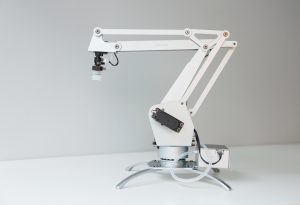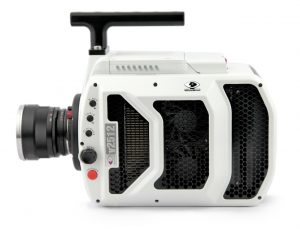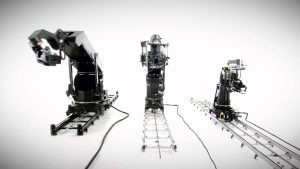Robotic arm in everyday life – a revolution that has been going on for many years. In what direction is it heading?
When you hear the word “robot” what vision does your mind create? In most cases, it is probably the image of humanoids which are designed in the shape of the human body. However, it will come as no surprise that everyday life is very different from the stories created in Hollywood. Therefore, robots, are usually mechanical devices that are programmed to perform well-defined and repetitive functions. In this case, we are using the robotic arm as an example which is a mechanical arm subjected to programming and has functions similar to a human arm. In what situations are robots used?
As a rule, mechanical devices perform work that is too time-consuming or dangerous for humans. However, due to advances in technology, and the miniaturization of Si systems, the precision and repeatability of movements, make robots irreplaceable in many working fields. More recently, the film industry, too, has been using the properties of robots to create unique shots.
Robotic arm, or how did it all begin?
But the history of robots begins much earlier than you might think. In 1206 a primitive robot, or more precisely, a programmable drum machine, was created. Its task was to play melodies to listeners who were in the Arab courts of the mighty. The world is rushing forward. Years pass and technology surprises us more and more. Although, we may think that robots are a relatively new technology, they have been evolving for nearly 900 years. Today’s robot arm in production plants or on movie sets in no way resembles the first robots. However, the operating philosophy is the same. The modern look of the robotic arm was formed in the 1960s.
Unimate – the world’s first robot arm
Unimation was founded by Joseph Engelberger and George Devol. They built the very first robotic arm. This device, weighing 1.8 tons, was created for the dangerous and repetitive work that had to be done on the General Motors production line in Trenton, USA. The robot arm worked on the operation of a high-pressure casting machine. Its task was to place heavy cast aluminum car parts into cooling containers. The robot took care of this monotonous and dangerous work, replacing employees working as many as 3 shifts.
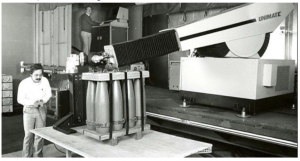
1963 and the creation of the Rancho Arm, one of the first artificial robotic arms that was controlled by a computer
In 1963, a robot arm was created, which had incredible 6 degrees of freedom and back then was considered exceptionally flexible. It was comparable to a human arm. Rancho Arm was designed for people with disabilities and was the first robot arm to be controlled by a computer.
2 years later, in 1965, Victor Scheinman and Larry Leifer invented a robotic arm called Orm which was powered by compressed air. Victor Scheinman was a student in mechanical engineering who also worked at Stanford University’s Artificial Intelligence Laboratory. In 1969, he built the Stanford Arm – a robotic arm with electronically driven axes. Interestingly, this solution still continues to influence robotic arm designs to this day.
More than 10 years later, in 1981 Take Kanade designed and buit a direct-drive robot arm which had its motors mounted directly in the joints. That idea translated into a much more accurate and faster mechanism making the robot more precise than ever.
Robot arm – a technological revolution.
The technological development is undoubtedly not slowing down. Robots, which are classified as industrial can be used for many applications. Very often they contribute to the implementation of complex manufacturing and assembly processes. However, it is worth being aware of the fact that they are also increasingly being used in more visible, or open, short circuits. In this context, it is worth mentioning the food robot. Back in 2018, a fast-food restaurant was opened in San Francisco, in which the food was prepared by a machine from start to finish. “The Burger Maker” is a complex food robot which the customers can use to fine-tune their burgers. With help of a team of engineers and chefs the founder and owner of the restaurant Alex Vardakstas built the food robot himself.
In recent years companies like Miso Robotics focus on eliminating dully and dangerous task in the kitchen by replacing human labor with robotic solutions. So far, they have patented a number of different products such as the “Flippy” – a robot arm station which can fry almost anything and has an automatic dispenser or “Cook Right Coffee” an artificial intelligence powered system designed to guarantee the perfect cup of coffee.
Robotic arm solutions in the film industry – the attention to precision in repetitive movements
We will move away for a moment from the conventional use of robotic systems used in industry or medicine and dive into the world of film. Up to this day, more than 50 years after its beginning, Mark Roberts Motion Control is still the leader in utilizing the capabilities offered by robots in the film industry. The history of Mark Roberts Motion Control and the company’s activities related to motion control, process automation and broadcast robotics are described in a separate article, here is a (link) to it. In 1991 they created the groundbreaking Milo. It is an instrument designed to control motion and camera operation, along with the focus and zoom control of the lens in use. In 2022, the company’s offer included the high-speed robot arms Bolt X and the compact Bolt JR+ which expanded the Bolt family.
In what productions can you see the effects of using motion control equipment?
What matters most in the film industry in terms of shooting scenes? From a producer’s point of view, it would be efficiency. A cameraman would emphasize on precision in the repetition of movements and the dynamic camera control. This is the standard these days. Are there any Harry Potter fans with us? It was Mark Roberts Motion Control that contributed to many of the exceptional effects when it came to creating the special shots in the series. Deathly Hallows – both the first and second installments were shot with motion control equipment. Similar is the case with such productions as Sherlock Holmes: A Game of Shadows, Star Wars: Skywalker Birth, and X-Men.
Motion Control Berlin offers, among others, a compact and fast to set up rig that stands out with its expandable range – the Bolt Junior+. It is the successor to the Bolt Jr but is lighter, more agile and more compact in size. At the same time, there are no compromises as far as payload is concerned which is 10 kg. Its small dimensions make it ideal for smaller studio spaces, and it is not complicated and expensive to transport.
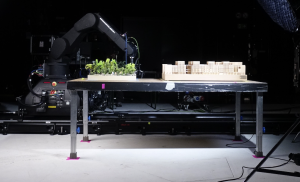
Era of Motion Control.
Motion control is a field of automation that controls the position or speed of machines, using devices such as hydraulic pumps, servo motors or linear actuators. Without Motion Control industrial mechanics and robotics cannot be used to its full potential. It is also used in packaging, printing, semiconductor manufacturing, assembly lines and the textile industry. Motion Control Photography is also a technique that takes advantage of the capabilities of precise motion control, and the repeatability of camera movements. The process consists of filming several elements using the same camera movement. These images are then composed into a single, consistent image. All of that creates new for modern cinematography. Especially since, in addition to repeatability, Motion Control allows, among other things, to perform mathematical operations on the motion path. Among them are rotation, panning, scaling and also changing speed both globally and locally.
Want to learn more about how an industrial robot differs from a robot arm, which is adapted to work on a film set? You’ll find this information in a comprehensive article on the Mark Roberts Motion Control brand. If you are looking for a robotic arm for rental, you can contact us. We encourage you to write us an e-mail.
Working hand-in-hand with robots.
The European Robotics Technology Platform is an organization that has been predicting for many years that the development of industrial robotics is moving in the direction of so-called collaborative robots. Much of this has to do, for example, with the fact that the original task of the robotic arm was to relieve humans of heavy, monotonous and dangerous work. For this reason, they were, in one way or another, separated from the employees of a given company. However, it is increasingly common to encounter robots which work with humans “shoulder to shoulder.
The first robot of that kind appeared on the market in 2013. What has changed that makes a human safe in their “company”? The modifications that were made were not only in the design or size of the device. They also affected the sphere of their equipment. Among other things, the robots were provided with properly integrated sensors. What’s more, concern for the safety of workers has made the robotic arm cooperating directly with a human being lightweight, deft and with relatively low strength. The integration of sensorial systems, lightweight design, efficient and refined safety systems make the robots behave responsive in a case of a direct contact with humans and make them appear as if they have feelings.
